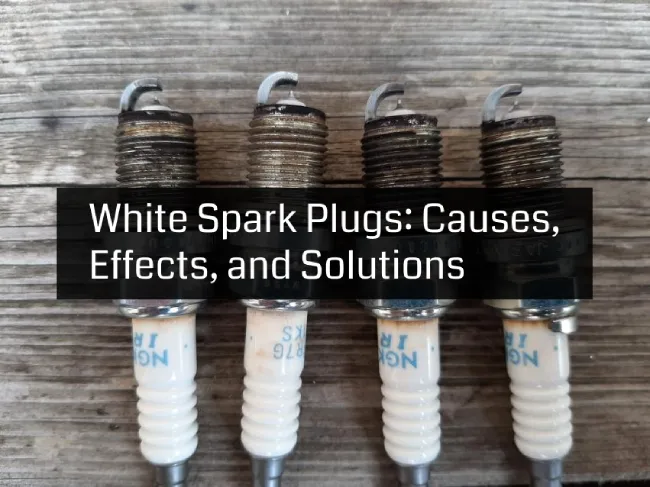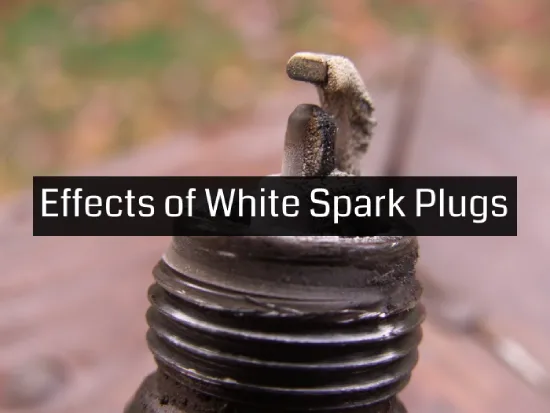Finding your engine’s spark plugs coated in a white, powdery substance can be alarming for any car owner. However, while disconcerting, white spark plugs are a common issue stemming from high operating temperatures inside the combustion chamber. They are less dangerous than black spark plugs, but the issue should still be addressed.
This white residue is usually harmless carbon and oil deposits that baked onto the insulator tip. But don’t ignore it – white plugs warn of impending performance issues and engine damage if left unchecked.
This article will explore what causes white spark plugs, how to diagnose the root problem, and most importantly, the solutions to restore your engine’s health. Properly addressing white deposits now prevents reduced fuel economy, difficult starting, stalling, and costly repairs down the road.
What Do White Spark Plugs Mean?
White spark plugs occur when deposits bake onto the insulator tip of the spark plug due to abnormally high combustion temperatures. Common causes include an engine running too hot, overly lean air/fuel mixture, and intake manifold leaks.
Effects of white plugs include reduced performance, potential engine damage, and increased emissions. Diagnosis involves a visual inspection, compression test, and analyzing fuel trim data.
Solutions include replacing with proper heat range plugs, fixing intake leaks, adjusting fuel mixture, using anti-seize lubricants, and shorter replacement intervals. Addressing white spark plugs is critical to prevent further issues and restore proper engine operation.
Causes of White Spark Plugs
Let’s see in more detail what is causing your spark plugs to turn white.

Running too hot
Spark plugs that appear white or blistered indicate the engine is running too hot, which causes the deposits to burn off leaving a white residue. This can be caused by several issues:
- Melted electrodes or white deposits on the insulator tip are signs the spark plug itself is overheating. This is usually caused by using the wrong heat range spark plug that cannot withstand the engine’s operating temperatures.
- Using a spark plug with too high of a heat range for the particular engine can cause overheating. Always use the manufacturer-recommended heat range for optimal performance and to avoid overheating.
- Ignition timing that is too advanced will cause the spark to fire earlier, leading to detonation and increased cylinder temperatures. Retarded ignition timing is better for reducing heat.
- An overheated engine from issues like a stuck thermostat, coolant leaks, or faulty water pump can transfer excessive heat to the spark plugs.
Lean fuel mixture
A lean air/fuel mixture means there is not enough fuel present for proper combustion. This leads to increased cylinder temperatures and white deposits on the spark plugs. Some causes include:
- Low fuel pressure caused by a worn fuel pump, clogged filter, or leaking injector prevents sufficient fuel delivery. This leans out the mixture.
- A faulty oxygen sensor can provide incorrect data to the PCM causing it to reduce fuel delivery and create a lean condition.
- High mileage engines often have leaking injectors and worn parts leading to inadequate fueling even with no other symptoms.
- A damaged intake manifold or leaking gasket allows extra air to enter, leaning out the mixture.
Intake manifold leaks
Cracks or loose fittings in the intake manifold allow extra air to enter the combustion chamber. This leans out the fuel mixture, causing it to burn hotter and leave white deposits on the spark plugs. Symptoms include:
- White plugs with no other apparent symptoms point to an intake leak.
- A vacuum leak makes it harder to start or causes a rough idle.
- The oxygen sensor will report a lean mixture, triggering lean fuel trim codes.
- A compression test can identify a consistent intake leak on all cylinders.
Diagnosing White Spark Plugs
So, how exactly can you diagnose the cause of white spark plugs? Here’s a quick guide!
Visual inspection
The first step is a visual inspection of the spark plugs:
- Remove each spark plug and check for any white deposits baked onto the insulator around the center electrode, or on the ground electrode.
- Compare to a new spark plug to see if the white color is abnormal or just normal wear. Severe discoloration indicates an issue.
- Look for signs of overheating like blistering, melting, or erosion of the electrodes. This points to excessive heat.
- Check if the deposits are wet or dry. Wet deposits indicate oil or coolant entry into the chamber.
Compression test
A compression test on all cylinders can help pinpoint intake leaks:
- Intake leaks will show lower compression on affected cylinders. Healthy engines should have uniform compression.
- Consistently low compression on all cylinders likely indicates worn piston rings are allowing blow-by. This points to high mileage issues.
- Compare to factory spec compression values. A difference of 10-15% indicates ring wear or intake leaks.
Fuel trim data
Scanning for fuel trim related trouble codes can identify intake leaks:
- Upstream oxygen sensors will report a lean condition, triggering codes like P0171 and P0174.
- The PCM will attempt to compensate by adding fuel, indicated by positive fuel trim values.
- Monitor short and long term fuel trim numbers for abnormally high positive readings, signaling the computer is trying to richen the mixture.
Solutions for White Spark Plugs
Most possible solutions can be done at home by yourself, but if you do not feel confident enough, leave it to the pros!
Replace with correct heat range plugs
If the current plugs are the wrong heat range, replace them with the proper plugs recommended by the manufacturer. Using the correct heat range for the engine design prevents overheating.
- Consult the owner’s manual or engine decal for the OEM spark plug type and heat range.
- Autolite, Bosch, NGK, and Champion plugs are common OEM suppliers. Match the same style plug.
- Heat range is denoted by the last digit or letter. Lower numbers are cooler.
Fix intake leaks
Any intake leaks must be repaired to prevent unmetered air from entering:
- Tighten loose intake manifold bolts or replace cracked gaskets. Use torque wrench for proper tightness.
- Replace damaged vacuum lines and components allowing unmetered air in.
- Use silicone sealant on stubborn manifold leaks. Avoid RTV sealant near oxygen sensors.
Adjust air/fuel mixture
The engine may need adjusted fuel delivery or timing to correct mixture issues:
- Replace faulty engine sensors like oxygen, temperature, or pressure sensors.
- Clean fuel injectors if flow testing shows reduced output. Consider professional ultrasonic cleaning.
- Adjust fuel pressure regulator if running too low. Spec is usually around 58 psi.
- Check for correct ignition timing and adjust if incorrect. Use timing light.
Use anti-seize lubricant on plug threads
Anti-seize lubricant prevents galling of the threads and makes future removal easier:
- Apply a small amount of high-temp anti-seize lube to plug threads before installing. Avoid electrode.
- This prevents heat-related seizure of the plugs during removal.
- Allows more consistent torque values during install.
More frequent replacement interval
If white plug issues persist, reduce the spark plug replacement interval:
- Replace at 30,000 miles instead of 60,000 miles.
- Some manufacturers recommend intervals as low as 10,000 miles for certain engines prone to deposits.
- Always use OEM-recommended replacement intervals as a baseline.
Effects of White Spark Plugs
So you might be asking yourself, is it ok to drive my car if I notice that my spark plugs have white deposits on them? The short answer is not for long.

Reduced engine performance
White spark plugs can significantly reduce engine performance in several ways:
- The white deposits left on the electrodes act as insulators, requiring higher voltage to fire the plug. This can lead to misfires and power loss.
- The deposits disrupt the spark, leading to incomplete combustion of the fuel-air mixture. This reduces power output.
- Misfires cause unburned fuel to enter the exhaust, which confuses readings from the oxygen sensor. This can cause further performance issues.
- Poor fuel economy results from incomplete combustion and reduced cylinder pressures. Expect 1-2 mpg fuel economy decrease.
Potential engine damage
Excessive cylinder heat from lean misfires or overadvanced timing can lead to costly engine damage:
- Melted pistons are a worst case scenario if detonation and overheating are severe. This requires extensive engine work.
- High temperatures put added stress on engine components like the head gasket, valves, and bearings, leading to premature failure.
- Cylinder head warping is possible over time from heat stress. This causes head gasket failure and coolant leaks.
Increased emissions
Lean misfires from white spark plugs increase vehicle emissions:
- Incomplete combustion leads to higher hydrocarbon (HC) emissions as unburned fuel escapes.
- Lean mixtures cause much higher oxides of nitrogen (NOx) emissions which contribute to smog.
- This greatly increases the likelihood of failing an emissions test for HC, NOx, or misfire codes.
- Excess emissions can degrade the performance of the catalytic converter over time as well.
Closing Thoughts
It is critical to address white spark plugs and determine the root cause rather than just replacing the plugs. Unresolved issues will lead to continued failure of new plugs. Properly diagnosing and repairing underlying problems prevents further damage and restores engine performance.
Routinely checking spark plugs and following manufacturer’s maintenance recommendations helps achieve peak engine performance and efficiency. Well-maintained engines last longer, produce fewer emissions, and will save you money in the long term.
Overall, white spark plugs are a warning sign of potentially serious issues that must be properly addressed. With the right diagnosis and repairs, engines can return to providing thousands of additional miles of reliable service.
Engineering Coordinator with 5+ years of experience in the automotive manufacturing industry. Currently supporting vehicle development and new model launch activities at Honda Development and Manufacturing of America. Skilled at managing engineering teams, overseeing prototype builds, coordinating testing, and driving continuous process improvements. LinkedIn








